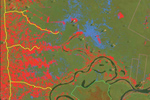White-tailed deer are usually thought of as inhabiting temperate forests in the U.S. and Canada, but this widespread species can also be found across tropical forests, from Mexico to Peru. A new study in mongabay.com’s open access journal Tropical Conservation Science investigates the population of white-tailed deer (Odocoileus virginianus) in Mexico’s Tehuacan-Cuicatlan Biosphere Reserve (TCBR), and finds that poaching may be having a large impact.
“Little information exists regarding the effects of human pressure on deer population densities. This pressure occurs mainly in ecosystems that are undergoing serious fragmentation, such as the tropical dry forest,” the study’s authors write.
Counting deer pellets, the researchers found that deer abundance ranged from 0.1 to 2.9 deer every square kilometer, making the species more rare than expected. The low density could possibly be explained by human impacts.
“These wild populations are currently under anthropogenic pressures such as […] habitat loss, competition with cattle for food and space, and poaching, which is one of the most important causes of wild fauna decline,” the authors write, noting that hunting may have an adverse impact on the populations given the difficulty of survival in dry forests.
The researchers suggest setting up Management Units for the Conservation of Wildlife (UMA) under Mexican law for the sustainable management of white-tailed deer populations by locals in the region. In addition, the authors recommend better management of cattle-ranching in the area to mitigate its impact on wildlife.
CITATION: Ramos-Robles, M.., Gallina, S. and Mandujano, S., C. 2013. Habitat and human factors associated with white-tailed deer density in the tropical dry forest of Tehuacan-Cuicatlan Biosphere Reserve, Mexico. Tropical Conservation Science Vol. 6(1):70-86.
Related articles
Extremely rare plant region left unprotected in the Yucatan Peninsula
(09/17/2012) For the first time, scientists have identified the areas of the Yucatan Peninsula that hold the highest concentrations of endangered woody plants, which includes trees, shrubs, and lianas. In doing so they uncovered four key regions, but also noted that the region with the highest concentration of extremely rare plants was left unprotected, according to a new paper in mongabay.com’s open access journal Tropical Conservation Science.
Dry forests disappearing faster than rainforests in Latin America
(08/21/2012) Countries across Latin America lost 78,000 square kilometers of subtropical and tropical dry broadleaf forests between 2001 and 2010, according to a new satellite-based assessment published in the journal Biotropica.
North American freshwater fish going extinct at rate over 800 times the fossil record
(08/14/2012) Since 1898 North America has lost at least 39 species of freshwater fish, according to a new study in Bioscience, and an additional 18 subspecies. Moreover, the loss of freshwater fish on the continent seems to be increasing, as the rate jumped by 25 percent since 1989, though even this data may be low.
Indonesia, Brazil, Mexico, Peru get big boost in deforestation tracking, biomass measurement

(07/11/2012) Efforts to rapidly and accurately track deforestation and forest degradation in Indonesia, Brazil, Mexico, and Peru got a boost this week with a special technical training session organized by the Governors Climate and Forest Task Force. The meeting, convened at Stanford University and Google’s Silicon Valley campus, paired staffers from government agencies and NGOs in the four tropical countries with technical experts from the Amazon Environmental Research Institute (IPAM), the Carnegie Institution for Science, the Forum on Readiness for REDD, Woods Hole Research Center, and Google Earth Outreach. The participants received training to augment existing deforestation, forest degradation and biomass monitoring capabilities, which are highly variable both between countries and within sub-national agencies and jurisdictions.